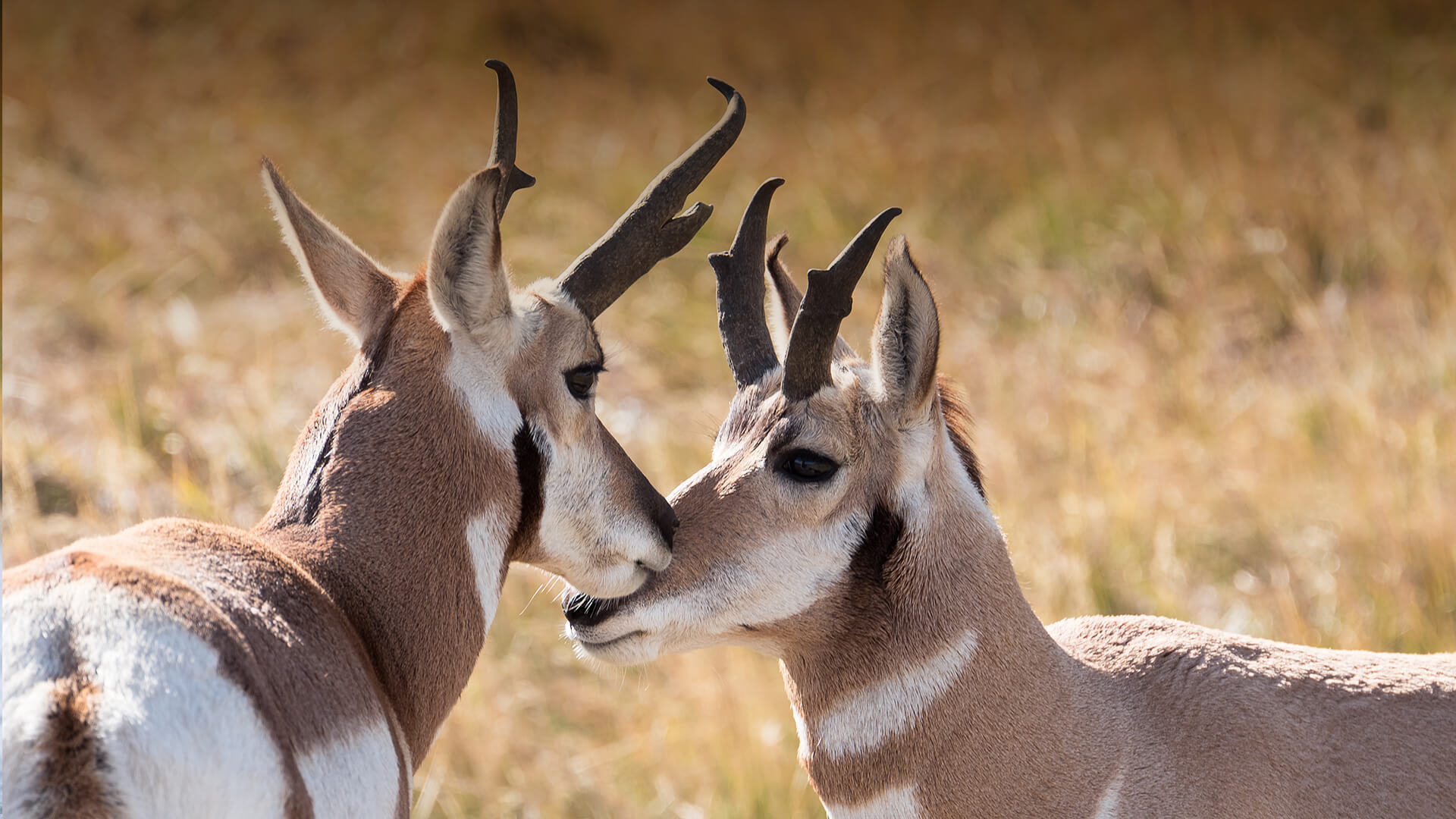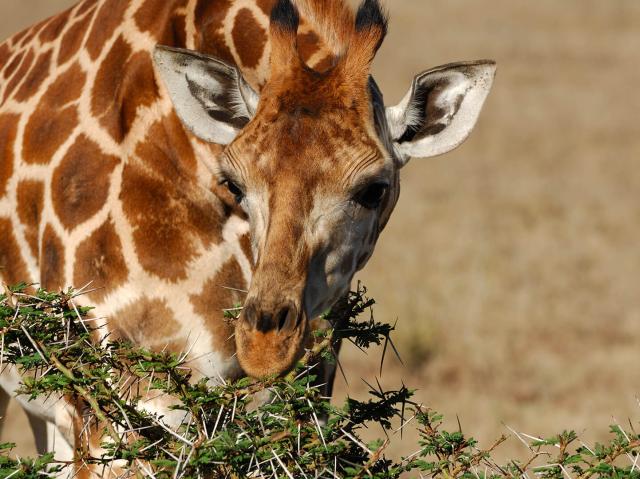
Pronghorn

- CLASS: Mammalia (Mammals)
- ORDER: Artiodactyla
- FAMILY: Antilocapridae
- GENUS: Antilocapra
- SPECIES: americana
- SUBSPECIES: americana (Wyoming pronghorn), mexicana (Mexican pronghorn), peninsularis (Peninsular pronghorn), sonoriensis (Sonoran pronghorn)

ABOUT
Although they’re often called antelope, pronghorn antelope, or American antelope, pronghorn are not true antelope. In fact, they’re unique enough to warrant their own taxonomic family, Antilocapridae. Pronghorn are native to North America and have no close relatives on any other continent. As such a significant North American species, they’ve been known by more than one hundred historic names in many languages.
The horns of a pronghorn help make them unique, as they share qualities of both horns and antlers. True antlers are made of bone and shed each year; true horns are made of compressed keratin and grow from a bony core but are never shed. The horns adorning a pronghorn have a sheath made of keratin and are shed yearly.
True horns have only one point, not the prongs or forks that antlers have. Yet a male (buck) pronghorn's horns can grow more than 15 inches (25 centimeters) long with a forward-facing prong. Hence their name: pronghorn. Female pronghorn (called does) also have horns, but they are much smaller. Pronghorn are the only animals in the world that have forked horns that shed each year!
A herd of sure-footed pronghorn dashing away looks like a group of cotton balls bouncing across their open, grassy, or desert habitat. Their tawny coats blend well with the dry landscape. A cotton-white rump patch serves as a beacon so the herd can stick together when fleeing. Their white underbelly and lower neck deflects heat rising from the ground. An outer layer of air-filled hairs helps them stay warm during winter. Come summer, they molt that coat and can erect their hair to stay cool.
Pronghorn have unique adaptations for spotting and evading predators such as wolves, foxes, coyotes, bobcats, and golden eagles. Pronghorn have large eyes to help them see predators. Scent communication allows them to mark territories and warn others of danger. Pronghorn bucks have nine scent glands and does have six. Glands beneath their ears help to mark territory during breeding time.
Glands on their rump are important when danger is near. If a pronghorn sees a predator, it releases an alarm odor from these glands while the white fur on its rump stands up. This sends a message by both sight and smell to let other pronghorn know of the danger. Pronghorn may defend themselves or their babies (fawns) by striking out with their hooves or by using their horns against a predator.
If a predator does manage to sneak up on a pronghorn, their amazing running skills come into action. Pronghorn are the fastest land mammals in North America. They can reach speeds of up to 60 miles (97 kilometers) per hour. This is not much slower than the fastest land mammal in the world, the cheetah. Yet pronghorn can maintain high speeds much longer than cheetahs can. A pronghorn's hooves have two long, pointed toes, cushioned to help absorb the shock when running at high speeds. Running with their mouth open allows pronghorn to take in lots of oxygen to fuel their running muscles. Although they are excellent runners, pronghorn are not good jumpers: if they come across a fence, they often go under it.
HABITAT AND DIET
Pronghorn are found in open prairie and desert habitats in western North America. Like many hoofed mammals, pronghorn spend their day—and night—eating and resting with their herd. As ruminants, they regurgitate partially-digested food and chew it again (chew their cud) while at rest. They rarely close their eyes to sleep, though, as they must remain alert for any potential danger. If they do sleep, it’s for less than 10 minutes at a time.
They are most active at dawn and dusk as they browse and graze on a variety of plants. They eat non-woody flowering plants first, if available. Shrubs, grasses, cactus, and domestic crops are also on the menu, depending on the time of year. Shrubs are important in wintertime, and pronghorn use their front feet to dig for food buried in the snow. A pronghorn's teeth are always growing, because they wear down as they grind food. Pronghorn drink when water is available, but they can go for weeks without it, getting moisture from their food.
At the San Diego Zoo Safari Park, pronghorn browse on fresh vegetation and eat hay.
FAMILY LIFE
During fall and winter, pronghorn live in large herds of up to 1,000 individuals. Each buck gathers three or four does in a small harem within the larger herd. Breeding takes place in September and October, with bucks defending and marking territories. Often, more dominant bucks have better territories with better food supplies to attract does. Yet females decide which males they want to breed with. They often stay with one male for a day or two before moving on to another to assess his fitness. Fawns born in the same litter often have different fathers.
Pronghorn have a longer gestation period than typical North American ungulates, averaging eight months. It is common for a mother to have twins. Fawns are born in late spring, when the large herd breaks up into smaller groups. Does seek time and space alone to give birth and care for their offspring. Incredibly, newborns can take their first wobbly steps just 30 minutes after birth. At four days old, they can outrun people, and in one week, they can run faster than a horse, if needed. A mother keeps her fawn hidden in tall prairie grasses, coming back to nurse her baby every few hours, until it is about two weeks old. She then returns to the herd with her baby.
Young are weaned when they are about 12 weeks old. Does can become mothers at age two. Bucks can sire fawns at about age three, although they have to prove they are worthy to prospective mates!
Adult male pronghorn have a large, black gland on their jaw below each eye. They mark objects with these glands and even display the glands to prospective mates. Males also mark their area by pawing the ground to create a clear spot, urinating in that spot, and then pooping in the center of the spot.
Pronghorn alert others to danger by snorting and stamping. During breeding season, males may snort and chug or wheeze. At regular intervals they growl, roar, and smack their lips. Mother pronghorn use a quiet bleat to call their offspring, and fawns (young) use a loud bleat if they are in danger.
CONSERVATION
No mammals, other than people and perhaps bison, have figured so prominently in the history of pioneer America as pronghorn. Early travelers to America's West told of pronghorn herds dotting the plains as far as the eye could see. They were more numerous than bison. About 100 million pronghorn provided settlers with an abundant food source. Native Americans also relied on pronghorn as a significant source of food and clothing. But as more settlers arrived in the West, pronghorn habitat and food declined.
By 1920, only about 13,000 pronghorn remained. Increased hunting contributed to this major decline. Early settlers tied handkerchiefs to poles and waved them in the air in a technique called flagging. This attracted curious pronghorn within gunshot range. Flagging is now illegal, and protection of habitat and restrictions on hunting have helped pronghorn populations to recover a bit.
Of the four pronghorn subspecies, two—Sonoran and Baja California pronghorn—are listed as Endangered by the U.S. Fish and Wildlife Service. Only about 500 peninsular pronghorn remain in Baja California, Mexico. Hunting, agriculture, cattle ranching (along with livestock fences), and predation by coyotes and golden eagles have led to the rapid decline of this subspecies.
Fortunately, conservation actions supported by allies like you are making a difference. San Diego Zoo Wildlife Alliance participates in the Peninsular Pronghorn Recovery Project (PPRP), a comprehensive and multifaceted conservation program working to establish sustainable populations in native habitats in Baja California and assurance populations in accredited zoos. Our recovery ecology teams are using innovative technology to observe how Peninsular pronghorn travel throughout their habitats. This helps conservation scientists understand what they need to thrive so that specific protection efforts with the greatest impacts can be made.
By joining San Diego Zoo Wildlife Alliance as an ally for wildlife, you help save species worldwide.
LIFE SPAN
7 to 11 years on average
YOUNG
Gestation: 8 months
Number of young at birth: 1 to 2
Weight at birth: 7 to 11 pounds (3 to 5 kilograms)
Age of maturity: 12-16 months
SIZE
Length: 4.2 to 4.6 feet (1.3 to 1.4 meters)
Height: 31 to 35 inches (80 to 90 centimeters) tall, at the shoulder
Weight: 87 to 129 pounds (40 to 59 kilograms); males are about 10 percent larger than females
FUN FACTS
Pronghorn have excellent vision: they can see movement as far as 3 miles (5 kilometers) away.
A pronghorn fawn can walk just 30 minutes after birth.
Pronghorn have the largest eyes of any North American ungulate in relation to body size. Each eyeball is about 1.4 inches (36 millimeters) in diameter.
The 1870s American folk song “Home on the Range” features pronghorn in the verse “where the deer and the antelope play.”










